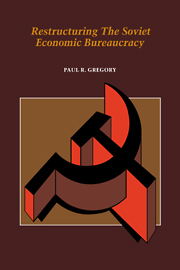3 - Organization
Published online by Cambridge University Press: 24 March 2010
Summary
Implementation of the bureaucratic design
The preceding chapter elaborated the logical design of the Soviet economic bureaucracy. We turn in this chapter to the implementation of this design in Soviet practice. We discuss the roles of the Council of Ministers, Gosplan, the functional committees, and the industrial ministries. Using the literature and interviews with middle-level bureaucrats as a basis, we study the functions, staff, and hierarchical conflicts of the Soviet economic bureaucracy.
The oversight level: the Council of Ministers
The USSR Council of Ministers (Sovet Ministrov SSSR) is the highest oversight and executive committee of the Soviet economic bureaucracy. It is responsible for the enactment of the economic policies of the Communist Party by the state bureaucracy.
Functions. The Council of Ministers is the highest executive organ of state power. Its duties and authority are spelled out in the Soviet constitution, which empowers the Council of Ministers to issue decrees and to monitor their execution. The Council of Ministers is the main source of economic legislation, orders, and decrees. Its edicts (called postanovlenie) vary from important statements of enterprises or ministry law to routine guidelines for individual ministries or organizations.
The Council of Ministers coordinates and directs the activities of the state committees and the ministries and the organizations subordinate to them. It supervises national economic planning, the state budget, and credit and currency systems. It forms state committees and has the right to countermand orders of ministers and heads of state committees.
- Type
- Chapter
- Information
- Restructuring the Soviet Economic Bureaucracy , pp. 25 - 53Publisher: Cambridge University PressPrint publication year: 1990

